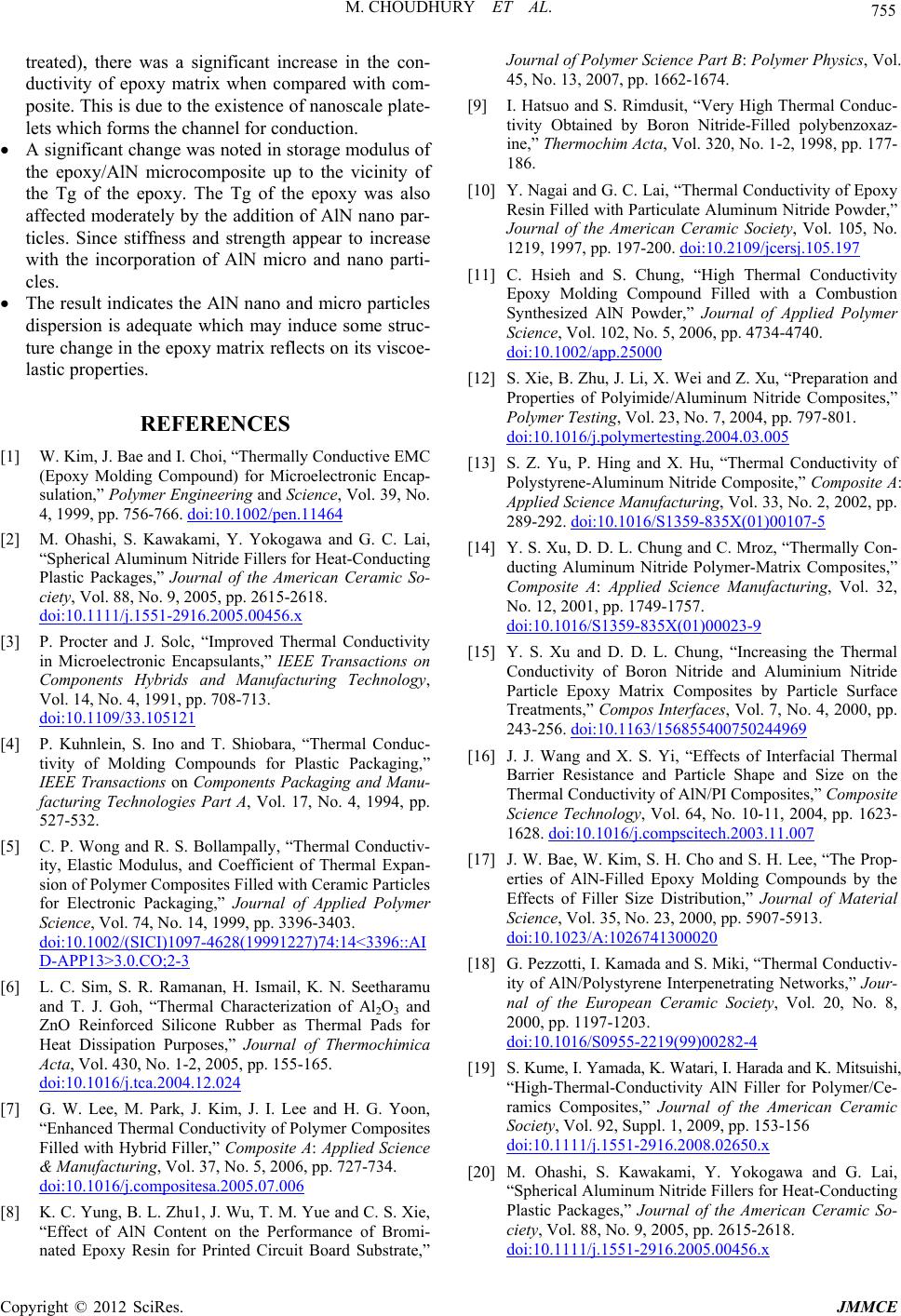
M. CHOUDHURY ET AL. 755
treated), there was a significant increase in the con-
ductivity of epoxy matrix when compared with com-
posite. This is due to the existence of nanoscale plate-
lets which forms the channel for conduction.
A significant change was noted in storage modulus of
the epoxy/AlN microcomposite up to the vicinity of
the Tg of the epoxy. The Tg of the epoxy was also
affected moderately by the addition of AlN nano par-
ticles. Since stiffness and strength appear to increase
with the incorporation of AlN micro and nano parti-
cles.
The result indicates the AlN nano and micro particles
dispersion is adequate which may induce some struc-
ture change in the epoxy matrix reflects on its viscoe-
lastic properties.
REFERENCES
[1] W. Kim, J. Bae and I. Choi, “Thermally Conductive EMC
(Epoxy Molding Compound) for Microelectronic Encap-
sulation,” Polymer Engineering and Science, Vol. 39, No.
4, 1999, pp. 756-766. doi:10.1002/pen.11464
[2] M. Ohashi, S. Kawakami, Y. Yokogawa and G. C. Lai,
“Spherical Aluminum Nitride Fillers for Heat-Conducting
Plastic Packages,” Journal of the American Ceramic So-
ciety, Vol. 88, No. 9, 2005, pp. 2615-2618.
doi:10.1111/j.1551-2916.2005.00456.x
[3] P. Procter and J. Solc, “Improved Thermal Conductivity
in Microelectronic Encapsulants,” IEEE Transactions on
Components Hybrids and Manufacturing Technology,
Vol. 14, No. 4, 1991, pp. 708-713.
doi:10.1109/33.105121
[4] P. Kuhnlein, S. Ino and T. Shiobara, “Thermal Conduc-
tivity of Molding Compounds for Plastic Packaging,”
IEEE Transactions on Components Packaging and Manu-
facturing Technologies Part A, Vol. 17, No. 4, 1994, pp.
527-532.
[5] C. P. Wong and R. S. Bollampally, “Thermal Conductiv-
ity, Elastic Modulus, and Coefficient of Thermal Expan-
sion of Polymer Composites Filled with Ceramic Particles
for Electronic Packaging,” Journal of Applied Polymer
Science, Vol. 74, No. 14, 1999, pp. 3396-3403.
doi:10.1002/(SICI)1097-4628(19991227)74:14<3396::AI
D-APP13>3.0.CO;2-3
[6] L. C. Sim, S. R. Ramanan, H. Ismail, K. N. Seetharamu
and T. J. Goh, “Thermal Characterization of Al2O3 and
ZnO Reinforced Silicone Rubber as Thermal Pads for
Heat Dissipation Purposes,” Journal of Thermochimica
Acta, Vol. 430, No. 1-2, 2005, pp. 155-165.
doi:10.1016/j.tca.2004.12.024
[7] G. W. Lee, M. Park, J. Kim, J. I. Lee and H. G. Yoon,
“Enhanced Thermal Conductivity of Polymer Composites
Filled with Hybrid Filler,” Composite A: Applied Science
& Manufacturing, Vol. 37, No. 5, 2006, pp. 727-734.
doi:10.1016/j.compositesa.2005.07.006
[8] K. C. Yung, B. L. Zhu1, J. Wu, T. M. Yue and C. S. Xie,
“Effect of AlN Content on the Performance of Bromi-
nated Epoxy Resin for Printed Circuit Board Substrate,”
Journal of Polymer Science Part B: Polymer Physics, Vol.
45, No. 13, 2007, pp. 1662-1674.
[9] I. Hatsuo and S. Rimdusit, “Very High Thermal Conduc-
tivity Obtained by Boron Nitride-Filled polybenzoxaz-
ine,” Thermochim Acta, Vol. 320, No. 1-2, 1998, pp. 177-
186.
[10] Y. Nagai and G. C. Lai, “Thermal Conductivity of Epoxy
Resin Filled with Particulate Aluminum Nitride Powder,”
Journal of the American Ceramic Society, Vol. 105, No.
1219, 1997, pp. 197-200. doi:10.2109/jcersj.105.197
[11] C. Hsieh and S. Chung, “High Thermal Conductivity
Epoxy Molding Compound Filled with a Combustion
Synthesized AlN Powder,” Journal of Applied Polymer
Science, Vol. 102, No. 5, 2006, pp. 4734-4740.
doi:10.1002/app.25000
[12] S. Xie, B. Zhu, J. Li, X. Wei and Z. Xu, “Preparation and
Properties of Polyimide/Aluminum Nitride Composites,”
Polymer Testing, Vol. 23, No. 7, 2004, pp. 797-801.
doi:10.1016/j.polymertesting.2004.03.005
[13] S. Z. Yu, P. Hing and X. Hu, “Thermal Conductivity of
Polystyrene-Aluminum Nitride Composite,” Composite A:
Applied Science Manufacturing, Vol. 33, No. 2, 2002, pp.
289-292. doi:10.1016/S1359-835X(01)00107-5
[14] Y. S. Xu, D. D. L. Chung and C. Mroz, “Thermally Con-
ducting Aluminum Nitride Polymer-Matrix Composites,”
Composite A: Applied Science Manufacturing, Vol. 32,
No. 12, 2001, pp. 1749-1757.
doi:10.1016/S1359-835X(01)00023-9
[15] Y. S. Xu and D. D. L. Chung, “Increasing the Thermal
Conductivity of Boron Nitride and Aluminium Nitride
Particle Epoxy Matrix Composites by Particle Surface
Treatments,” Compos Interfaces, Vol. 7, No. 4, 2000, pp.
243-256. doi:10.1163/156855400750244969
[16] J. J. Wang and X. S. Yi, “Effects of Interfacial Thermal
Barrier Resistance and Particle Shape and Size on the
Thermal Conductivity of AlN/PI Composites,” Composite
Science Technology, Vol. 64, No. 10-11, 2004, pp. 1623-
1628. doi:10.1016/j.compscitech.2003.11.007
[17] J. W. Bae, W. Kim, S. H. Cho and S. H. Lee, “The Prop-
erties of AlN-Filled Epoxy Molding Compounds by the
Effects of Filler Size Distribution,” Journal of Material
Science, Vol. 35, No. 23, 2000, pp. 5907-5913.
doi:10.1023/A:1026741300020
[18] G. Pezzotti, I. Kamada and S. Miki, “Thermal Conductiv-
ity of AlN/Polystyrene Interpenetrating Networks,” Jour-
nal of the European Ceramic Society, Vol. 20, No. 8,
2000, pp. 1197-1203.
doi:10.1016/S0955-2219(99)00282-4
[19] S. Kume, I. Yamada, K. Watari, I. Harada and K. Mitsuishi,
“High-Thermal-Conductivity AlN Filler for Polymer/Ce-
ramics Composites,” Journal of the American Ceramic
Society, Vol. 92, Suppl. 1, 2009, pp. 153-156
doi:10.1111/j.1551-2916.2008.02650.x
[20] M. Ohashi, S. Kawakami, Y. Yokogawa and G. Lai,
“Spherical Aluminum Nitride Fillers for Heat-Conducting
Plastic Packages,” Journal of the American Ceramic So-
ciety, Vol. 88, No. 9, 2005, pp. 2615-2618.
doi:10.1111/j.1551-2916.2005.00456.x
Copyright © 2012 SciRes. JMMCE